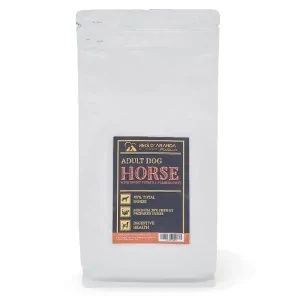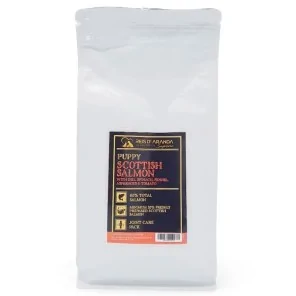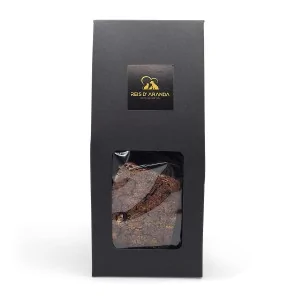The Tornjak originated from genetically homogeneous, almost extinct, indigenous shepherd dogs. These dogs have...
THE BROHOLMER
INTRODUCTION
The Broholmer is a molosser type dog breed, originally from Denmark. It is used as a companion dog, as it is calm, good tempered and friendly. However, it is also a good watchdog.
THE HISTORY OF THE BROHOLMER
They come from the mastiffs sent from England to the great Danish lords and there they were bred with the dogs they already had. Probably in the beginning they were more of a type of Great Dane, which evolved into the present Broholmer.
The type of this breed is known from the Middle Ages, when it was used as a deer hunting dog. Later it was used as a guard dog for large farms and feudal lands. At the end of the 18th century, these dogs were bred in purebred form and increased in numbers thanks to Count Sehested of Broholm, from whom the breed inherited its name.
After the Second World War the breed was on the verge of extinction, but around 1975 a group of fanciers took over the guardianship of the breed, subsequently organised under the name Society for the Reconstruction of the Broholmer Breed and sponsored by the Danish Kennel Club began their work of reconstruction.
After the incredible efforts of this group of people to save the breed from extinction, and whose work was also thanks to the help of the Danish Kennel Club, as we have already mentioned, the breed began to have a greater number of imports and people adopting it.
But despite this, it was not until 1998 that the breed was officially recognised by the Fédération Cynologique Internationale (FCI). It is believed that the reason for this delay was largely due to the lack of information about the breed's origins and crossbreeding.
Then, in 2009, the first Broholmer crossed the ocean to the Americas, making the breed even more widely known and internationalised.
WHAT IS THE BROHOLMER LIKE?
GENERAL APPEARANCE: The Broholmer is a large, rectangular, strongly built dog of the pug type, with regular and energetic movement. His appearance is dominated by the powerful forelegs. The head is massive and broad; the neck is strong with some loose skin; the chest is broad and deep. At rest the head is carried rather low and inclined towards the ground, the tail hanging down in a sabre-like fashion. When on the move, the tail is carried higher, but not above the back line. When the dog is alert or excited, the head is carried high and the tail is raised above the horizontal.
IMPORTANT PROPORTIONS: Skull and muzzle are of equal length.
HEAD: Rather large and broad, with a heavy appearance.
CRANIAL REGION:
SKULL: Broad and rather flat. The topline of the skull is parallel, but a little higher than that of the muzzle.
STOP: Not very pronounced.
FACIAL REGION:
TRUFFLE: Full and black.
HOCIO: Massive, rather short in appearance due to the heavy head.
BELLOWS: Pendulous, but not excessively so.
JAWS / TEETH: Powerful jaws with well developed muscles. Upper and lower jaw of equal length. Scissor or pincer bite.
EYES: Round, not too large. Colour light to dark amber. Expression should show great self-confidence.
EARS: Of medium size, set rather high. Set close to the cheeks.
NECK: Extremely powerful and muscular with some but not excessive dewlap.
BODY :
UPPER LINE: Straight.
WITHERS : Strong and clearly defined.
BACK: Rather long.
Croup: Of medium length, slightly sloping.
CHEST: Powerful and deep, with well developed forechest.
TAIL: Set on rather low, broad at the base. Carried drooping without flag or feathering. When in motion, the tail is raised to a horizontal position, preferably not too high. Should never be carried over the back or curled.
LIMBS
FOREQUARTERS:
GENERAL APPEARANCE: Strong, straight and powerful with muscular arms. Length and angulation of bone should produce free movement with good reach in both walking and trotting.
ARM: Very muscular.
ELBOW: Moving close to the body.
FOREARM: Straight and powerful.
Pastern: Not too long.
HANDS: Rounded and closed.
HINDQUARTERS:
GENERAL APPEARANCE: Powerful and muscular with angulation allowing good drive. Seen from behind, straight and parallel.
Upper thigh: Powerful and muscular.
METATARSE: Not too long.
FEET: Tight, like the front feet.
GAIT / MOVEMENT: Regular with head bent towards the ground. Natural movements are walk and trot.
SKIN: Well pigmented and thick; generally profuse, especially on the neck.
COAT: Short, close fitting and close fitting. Thick undercoat.
COLOUR: Yellow with black mask. Golden red. Black. White markings on chest, feet and tip of tail are optional.
SIZE AND WEIGHT:
HEIGHT AT WITHERS:
- MALES: approximately 75 cm,
- FEMALES: approximately 70 cm.
WEIGHT:
- MALES: 50 - 70 kg
- FEMALES: 40 - 60 kg.
FAULTS: Any departure from the foregoing points should be considered a fault and the seriousness with which the fault should be regarded should be in exact proportion to its degree and its effect upon the health and welfare of the dog.
- Very light and sleek in head and body.
- Very pronounced nasal-frontal depression; very slight muzzle; corners of lips pendulous.
- Lack of substance; insufficient development of forechest and depth of chest.
- Ears too large or too small.
- Rose ears.
- Tail set on too high or too low.
- Hook tail or curled tail.
- Metacarpus long and weak; flat feet.
- Cow hocks.
- Very elegant movement.
- Feathering of buttocks and tail.
DISQUALIFYING FAULTS:
- Aggressiveness or extreme shyness.
- Any dog showing clear signs of physical or behavioural abnormalities.
- Nervous, biting or aggressive.
- Square build, definitely insufficient substance.
- Nose of any colour other than black.
- Undershot or overshot mouth.
- Eyes of a different colour.
- Erect ears.
- Curled tail.
- Coat: wrong colour; long hair.
N.B.:
- Male dogs should have two apparently normal appearing testicles fully descended into the scrotum.
- Only functionally and clinically healthy dogs of typical breed conformation should be used for breeding.
HEALTH OF THE BROHOLMER
Hip and elbow dysplasia are two conditions prevalent in this breed. Both conditions have a strong hereditary component and can affect mobility.
Gastric torsion is also a disease that occurs with some frequency in Broholmer dogs. It is best avoided by not feeding large amounts of food and by not exercising after feeding.
Heart problems are also common, as are entropion, ectopion and cataracts. Make sure to have a veterinary check-up every six months to a year to keep your companion in good health.
A Broholmer's oral health is very important, as they tend to have many problems in this area. Try to brush their teeth every day, as if you let too much time go by their hygiene will become increasingly poor.
THE BROHOLMER'S PERSONALITY
Also known as the Danish Mastiff, the Broholmer is one of the most sought-after breeds for home care, especially if there are children. Although it is not one of the most famous and well-known breeds in Europe (as it is difficult to find it outside its country of origin), there is an increasing number of people looking for the Broholmer because of its important quality: its character.
His unblemished character, so affable, amusing, playful and loyal, has preceded him all these years, making him one of the most sought after dogs as a guardian of the home and protector of the children of the house.
CONCLUSION
Today, most Broholmers are companion and guard dogs. His physique and behaviour are essential characteristics of the breed, being calm, balanced and affable, yet always alert and confident.
Leave a comment
Log in to post comments
















